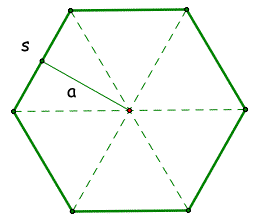Proof for area of any Regular Polygon 2!

Here is the link to my previous proof for the area of any quadrilateral being where a is the apothem and p is the perimeter. These two notes are quite closely related and the other note helps you to get a better understanding of this note but it is not at all necessary.
In this note, I will prove that the area of any polygon is where n is the number of sides and a is the side length.
We start by drawing lines to each of the vertices of the polygon. Each of the angles will be congruent and of course add up to 360 deg. Thus since there are n angles (n being the number of sides), each angle is .
Next, we draw the perpendicular bisectors of each side. Because each of the interior triangles is isosceles, the bisector will bisect both the angle and the side length. This makes the base of each "half" triangle and the angle closest to the polygon's in-center ).
Next, we find the height of the triangle (which is equivalent to the apothem. In this case, because we are given the angle closest to the incenter of the polygon and the corresponding opposite side length , we must multiply the base by . By doing this, we are left with the height since cot represents (in this case) the .
Then, we get the area of each triangle .
Finally, because there are as many triangles as there are sides, we multiply our formula by n (the number of sides and are left with .
Easy Math Editor
This discussion board is a place to discuss our Daily Challenges and the math and science related to those challenges. Explanations are more than just a solution — they should explain the steps and thinking strategies that you used to obtain the solution. Comments should further the discussion of math and science.
When posting on Brilliant:
*italics*or_italics_**bold**or__bold__paragraph 1
paragraph 2
[example link](https://brilliant.org)> This is a quote# I indented these lines # 4 spaces, and now they show # up as a code block. print "hello world"\(...\)or\[...\]to ensure proper formatting.2 \times 32^{34}a_{i-1}\frac{2}{3}\sqrt{2}\sum_{i=1}^3\sin \theta\boxed{123}Comments
Good work. (y)
Write a comment or ask a question...
Log in to reply
Haha. Good use of the back ground text.
Shouldn't the formula be n (a^2)tan(pi/n) paragraph 2 If "a" is the radius, then the area converges to pi at n=infinity
Log in to reply
Well, if we try a triangle of side length 6, the area is 93. By your formula, it's supposedly 3(36)tan(60)=1083
Log in to reply
"a" is the radius, not the side length. If it was the side length, then your formula is correct. Your diagram made it confusing.
absolutely brilliant well said
Absolutely brilliant!!!!!!!! well said
gr8 work
This is great work. I have yet to understand trigonometry to this extent.
awesome work.
awesome work,
45
awesome!!!!!!!!! well said :)
thanks a lot
toooooooooo good
you cheat !!!!!!!(to sumit sakarkhar
Could we say the triangles formed are equilateral? For example a hexagon would have 6 equilateral triangles area would be 6a^2root(3)/4 ??